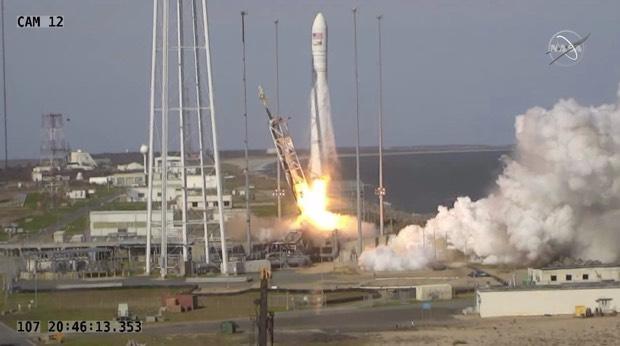Rocket launches with cargo for International Space Station
After loading last-minutes supplies, including a habitat housing 40 mice, Northrop Grumman launched an Antares rocket and Cygnus supply ship from Virginia's eastern shore Wednesday, kicking off a two-day flight to the International Space Station, the second of three resupply flights planned in just three weeks.
Liftoff from pad 0A at the Mid-Atlantic Regional Spaceport — MARS — at NASA's Wallops Island, Va., test facility came on time at 4:46 p.m. EDT (GMT-4), allowing the rocket to launch directly into the plane of the station's orbit — a requirement for rendezvous missions.
The climb to space went smoothly and the 139-foot-tall Antares 230 rocket, powered by two Russian RD-181 first stage engines and a Northrop Grumman solid-propellant upper stage, put the Cygnus cargo ship into the planned preliminary orbit about nine minutes after liftoff.
The automated rendezvous is designed to bring the Cygnus to a point about 30 feet directly below the lab complex around 5:30 a.m. Friday morning. It then will hold position while astronaut Anne McClain operating the station's robot arm, locks onto a grapple fixture.
From there, flight controllers at the Johnson Space Center in Houston will take over, remotely operating the arm to pull the supply ship in for berthing at the Earth-facing port of the central Unity module.
On board are 7,575 pounds of equipment and supplies, including 2,065 pounds of crew food, clothing and other material, 3,459 pounds of research hardware, including the mouse habitat, 1,384 pounds of space station hardware and 140 pounds of spacewalk gear, computer equipment and other items.
In addition to the station-bound cargo, the second stage of the Antares also carried a small Cubesat and 63 even smaller satellites built by students representing more than 70 schools across nine states. The "ThinSats," each a little larger than a deck of cards, were equipped with simple sensors and other systems to measure aspects of the space environment before falling back into the atmosphere and burning up five to 10 days after release.
Data from the ThinSats will be relayed back to classrooms over the internet via radio links with Globalstar relay stations.
"If you can get these kids turned on, boy, you better step out of the road or they're going to run right over the top of you," said Bob Twiggs, professor of Astronautics and Space Science at Morehead State University and an enthusiastic leader of the drive to develop small, low-cost satellites for research and STEM initiatives.
"So doing something like this at a cost that you could get down to the elementary schools, I think is really great," he said.
Three larger Cubesats will be deployed after the Cygnus departs the station in late July and another seven will be launched from the station through an airlock in the Japanese Kibo laboratory module.
The Antares-Cygnus flight comes just 13 days after launch of a Russian Progress supply ship from the Baikonur Cosmodrome in Kazakhstan. SpaceX is gearing up to follow the Cygnus flight with launch of a Falcon 9 rocket April 26 to send a Dragon cargo ship to the station from Cape Canaveral, the company's 17th operational resupply mission.
In a first for Northrop Grumman, the Cygnus spacecraft now features a "pop-top" nose cone fairing that allows the late stowage of time-critical biological samples after the launcher has been hauled to the pad. The mice and about 500 pounds of late-stow cargo was loaded aboard overnight Tuesday.
"Almost half the cargo Cygnus is bringing is dedicated to science on the International Space Station," said Pete Hasbrook, manager of the International Space Station Program Science Office.
"A lot of our science and our samples are life limited, whether they are living samples, they need a life support system or whether they need to be temperature controlled," he said. "So this late-load capability is very important for us, and we really appreciate what Northrop Grumman has done."
The mice are on board as part of a study to learn more about how the immune system is affected by weightlessness, higher radiation levels and other aspects of the space environment. Frozen tissue samples will be returned to Earth aboard a SpaceX Dragon capsule later this year.
A Canadian Space Agency Bio-Analyzer is going to the station to speed up analysis of blood, urine and saliva samples, along with a vascular aging investigation to shed light on what causes artery walls to thicken during long-duration spaceflight and how insulin resistance is triggered.
A variety of technology development projects also are on board, including a commercial facility to produce high-quality optical fibers, an experimental carbon dioxide removal system and two small free-flying robots known as "Astrobees" that can autonomously move about the station or be remotely controlled from the ground.
"These will be soon flying around in the U.S. segment of the space station, helping astronauts out, doing some routine chores for them and also doing more research and science as a microgravity testbed," said Maria G. Bualat, Astrobee project manager at NASA's Ames Research Center.
The cube-shaped battery-powered Astrobees will replace earlier robots known as SPHERES that were initially designed to test control theory algorithms. The new models feature multiple "payload bays" where sensors or other instruments can be mounted and a high-definition video camera.
"We can use the camera to do video surveys or to observe crew activities so the ground can be ready to answer any question the crew might have in a complex activity," Bualat said. "The other thing we can do is we can carry other instruments. We can carry sensors for environmental understanding, for example CO2 sensors, we can carry radiation sensors."
And when battery power runs low or a job is complete, the Astrobees can fly themselves back to a charger. "It's sort of your in-space Roomba," Bualat joked.
The flight marked Northrop Grumman's eleventh space station resupply mission since January 2014 — the final flight under the company's initial NASA resupply contract — and the fifth using the upgraded Antares 230, which replaced an earlier version of the rocket that suffered a catastrophic launch explosion in 2014.
The total value of Northrop Grumman's initial NASA commercial resupply contract, including modifications through 11 flights, was expected to total $2.89 billion, according to NASA's inspector general. The company also holds a follow-on contract for at least six resupply missions through 2024 at an as-yet-unspecified cost.
SpaceX holds NASA contracts for commercial resupply missions totaling $3.04 billion for 20 flights. Like Orbital, SpaceX holds a follow-on contract for additional flights.






